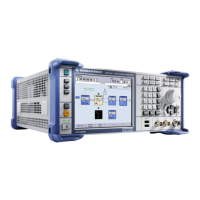Instrument Function
R&S
®
SMBV100A
301Operating Manual 1176.8016.02 ─ 17
I/Q-Swap - I/Q Mod
Selects normal or swapped I/Q control for an external analog signal. The modulation
sidebands are inverted by swapping the I and Q signals.
This parameter enables I/Q modulation to be performed on signals according to
IS2000 (cdma2000 standard) and the majority of all other standards. As a result, an I/Q
demodulator defined according to IS2000 can also be used for demodulating the gen-
erated signals.
The I/Q modulator defined in the IS2000 standard differs from the definition in the
R&S SMBV. The definition on which the R&S SMBV is based is used by virtually all
digital communication standards (except IS95 and IS2000).
In the final step, the filtered I/Q signal is modulated to the desired RF in a different way
in the I/Q modulator:
Figure 5-12: Definition of I/Q modulator in IS2000 and R&S
SMBV f
According to IS2000, the RF signal s(t) is derived from the baseband I/Q signal as fol-
lows:
s(t)=i(t)cos(2pif
c
t)+q(t)sin(2pif
c
t)
The instrument family is based on the following definition:
s(t)=i(t)cos(2pif
c
t)-q(t)sin(2pif
c
t)
"I/Q Swap" must now be set to "On" so that an I/Q modulator defined according to
IS2000 can cope with the RF signal generated by the R&S SMBV.
"Off"
I/Q control is normal.
"On"
The I and Q signals are swapped.
Remote command:
[:SOURce<hw>]:IQ:SWAP[:STATe] on page 748
I/Q-Wideband - I/Q Mod
Optimized setting for wideband modulation signals (>5 MHz). Optimized setting for
wideband modulation signals (>5 MHz).
I/Q Modulation - I/Q Mod Block

